Citroen C5 RHD 2015 (RD/TD) / 2.G User Guide
Manufacturer: CITROEN, Model Year: 2015, Model line: C5 RHD, Model: Citroen C5 RHD 2015 (RD/TD) / 2.GPages: 362, PDF Size: 32.4 MB
Page 11 of 362
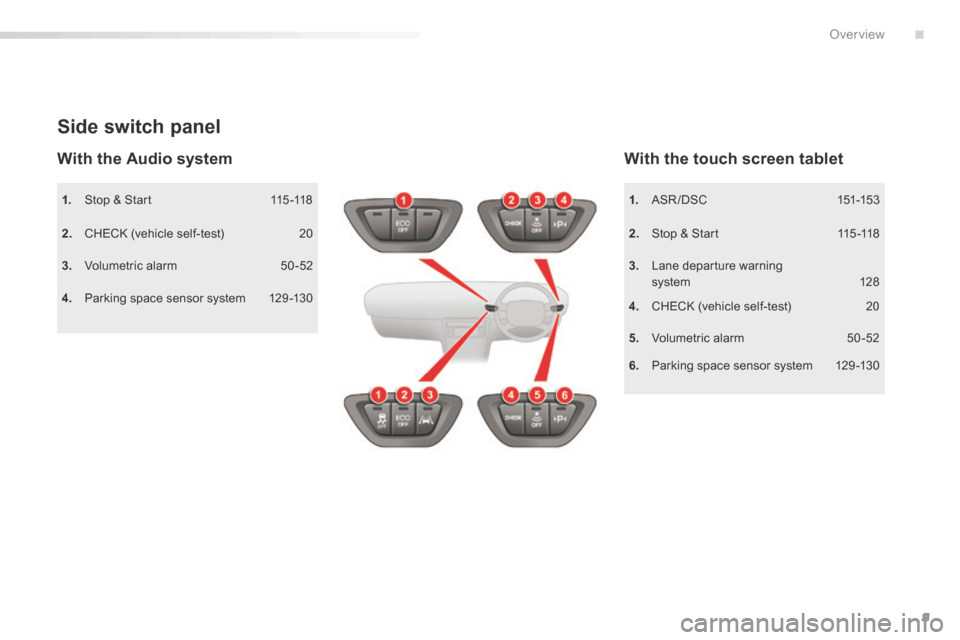
9
1. Stop & Start 115 -118
2. CHECK (vehicle self-test) 20
3. Volumetric alarm 50-52
Side switch panel
4. Parking space sensor system 129 -130
With the touch screen tablet
1. ASR / DSC 151-153
2. Stop & Start 115 -118
3. Lane departure warning
system 128
4. CHECK (vehicle self-test) 20
5. Volumetric alarm 50 -52
6. Parking space sensor system 129 -130
With the Audio system
.
Over view
Page 12 of 362

10
Exterior lighting 136-140
Automatic illumination of headlamps 140
Daytime running lamps 139
Direction indicators 148
Instruments and controls
Speed limiter 122-124
Cruise control 125 -127 Automatic rain sensitive wipers
144-147
Wash-wipe 145
Automatic wiping 146
Headlamp adjustment 141
Main menu - Instrument panel screen 15 -16
Trip computer 17, 19Fixed centred controls steering
wheel 120 -121
bluetooth telephone 284, 300 -307, 323 -325 Hor n
149
Navigation
258-271
Radio / Media 272-285, 318 -323
Selection of the displayed function - MODE 37, 256
Main menu - Audio system
38, 318
Main menu - Touch screen tablet 41, 257
Voice recognition - MirrorLink 256, 298 -299
Black Panel
256, 317
Audio controls - Audio system 317
Audio controls - Touch screen tablet 256
Steering mounted controls
over view
Page 13 of 362
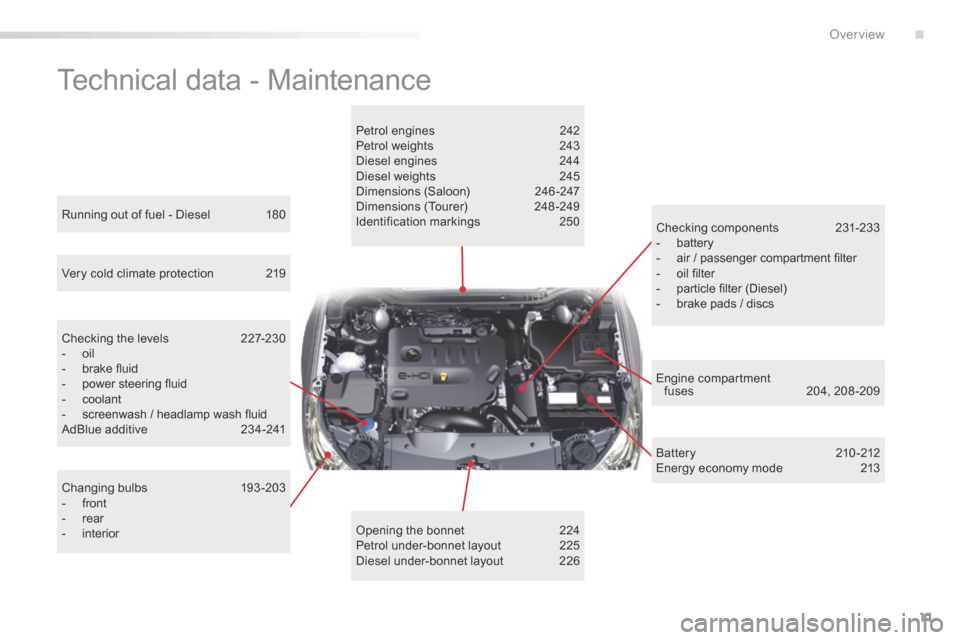
11
Technical data - Maintenance
Petrol engines 242
Petrol weights 243
Diesel engines 244
Diesel weights 245
Dimensions (Saloon) 246-247
Dimensions (Tourer) 248 -249
Identification markings 250
Opening the bonnet 224
Petrol under-bonnet layout 225
Diesel under-bonnet layout 226
Running out of fuel - Diesel
180
Checking the levels 227-230
- oil
- brake fluid
- power steering fluid
- coolant
- screenwash / headlamp wash fluid
AdBlue additive 234-241
Very cold climate protection
219
Changing bulbs 193-203
- front
- rear
- interior Checking components
231-233
- battery
- air / passenger compartment filter
- oil filter
- particle filter (Diesel)
- brake pads / discs
Batter y 210 -212
Energy economy mode 213
Engine compartment
fuses 204, 208 -209
.
over view
Page 14 of 362

12
Optimise the use of your gearbox
With a manual gearbox, move off gently and change up without waiting.
During acceleration change up early.
With an automatic or electronic gearbox, give preference to automatic
mode and avoid pressing the accelerator pedal heavily or suddenly.
Control the use of your electrical
equipment
Before moving off, if the passenger compartment is too warm, ventilate it
by opening the windows and air vents before using the air conditioning.
Above 30 mph (50 km/h), close the windows and leave the air vents
open.
Remember to make use of equipment that can help keep the
temperature in the passenger compartment down (sunroof and window
blinds...).
Switch off the air conditioning, unless it has automatic regulation, as
soon as the desired temperature is attained.
Switch off the demisting and defrosting controls, if not automatic.
Switch off the heated seat as soon as possible.
Switch off the headlamps and front foglamps when the level of light
does not require their use.
Avoid running the engine before moving off, particularly in winter; your
vehicle will warm up much faster while driving.
As a passenger, if you avoid connecting your multimedia devices
(film, music, video game...), you will contribute towards limiting the
consumption of electrical energy, and so of fuel.
Disconnect your portable devices before leaving the vehicle.
Eco-driving
Eco-driving is a range of everyday practices that allow the motorist to optimise their fuel consumption and CO2 emissions.
The gear efficiency indicator invites you engage the most suitable gear:
as soon as the indication is displayed in the instrument panel, follow it
straight away.
For vehicles fitted with an electronic or automatic gearbox, this
indicator appears only in manual mode.
Drive smoothly
Maintain a safe distance between vehicles, use engine braking rather
than the brake pedal, and press the accelerator progressively. These
practices contribute towards a reduction in fuel consumption and
Co
2 emissions and also helps reduce the background traffic noise.
If your vehicle has cruise control, make use of the system at speeds
above 25 mph (40 km/h) when the traffic is flowing well.
Eco-driving
Page 15 of 362
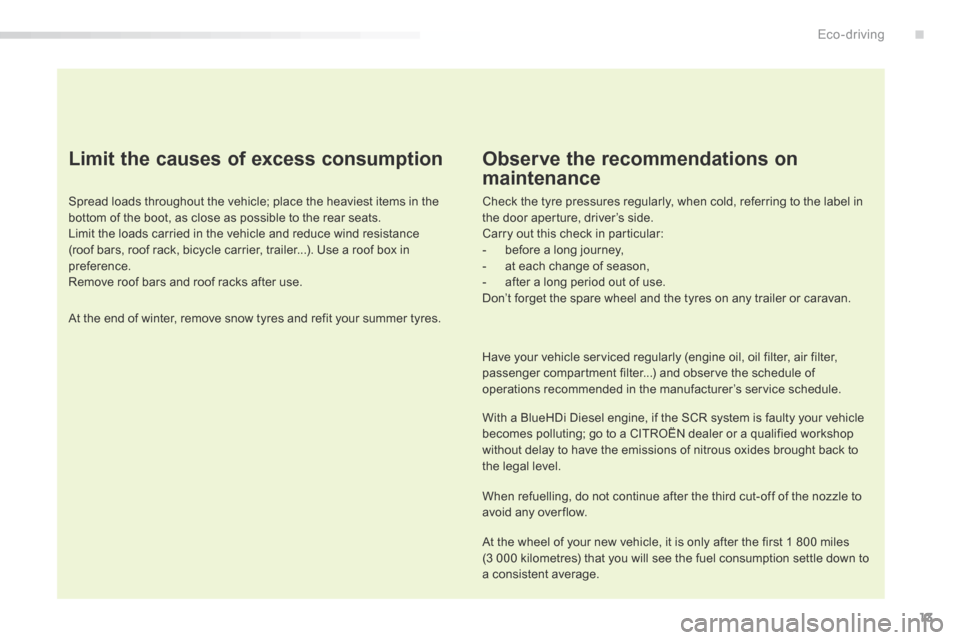
13
Limit the causes of excess consumption
Spread loads throughout the vehicle; place the heaviest items in the
bottom of the boot, as close as possible to the rear seats.
Limit the loads carried in the vehicle and reduce wind resistance
(roof bars, roof rack, bicycle carrier, trailer...). Use a roof box in
preference.
Remove roof bars and roof racks after use.
At the end of winter, remove snow tyres and refit your summer tyres.
Observe the recommendations on
maintenance
Check the tyre pressures regularly, when cold, referring to the label in
the door aperture, driver’s side.
Carry out this check in particular:
- before a long journey,
- at each change of season,
- after a long period out of use.
Don’t forget the spare wheel and the tyres on any trailer or caravan.
Have your vehicle serviced regularly (engine oil, oil filter, air filter,
passenger compartment filter...) and observe the schedule of
operations recommended in the manufacturer’s service schedule.
With a BlueHDi Diesel engine, if the SCR system is faulty your vehicle
becomes polluting; go to a CITROËN dealer or a qualified workshop
without delay to have the emissions of nitrous oxides brought back to
the legal level.
When refuelling, do not continue after the third cut-off of the nozzle to
avoid any over flow.
At the wheel of your new vehicle, it is only after the first 1 800 miles
(3 000 kilometres) that you will see the fuel consumption settle down to
a consistent average.
.
Eco-driving
Page 16 of 362
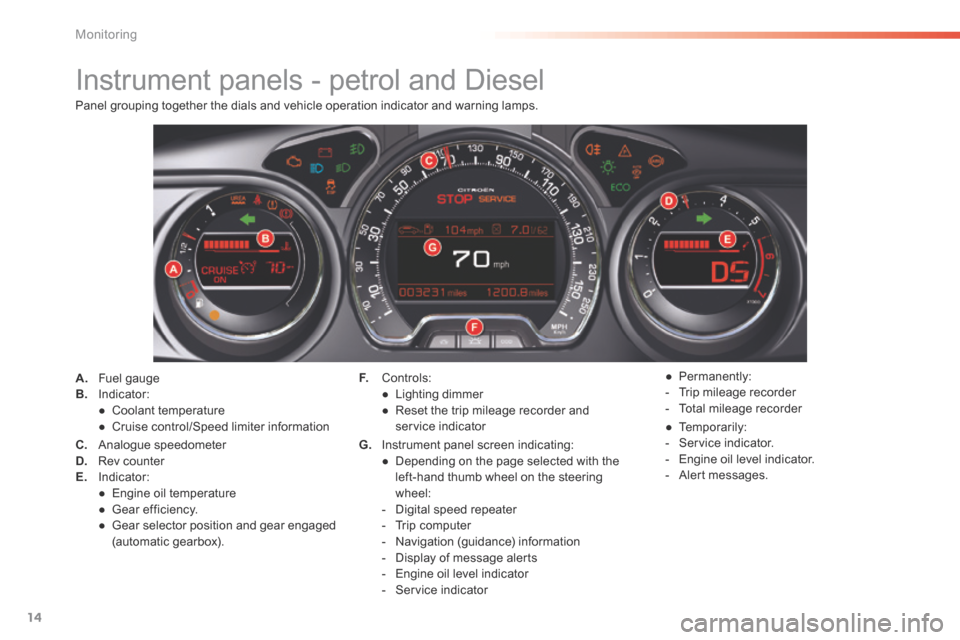
14
Instrument panels - petrol and Diesel
A. Fuel gauge
B. Indicator:
● Coolant temperature
● Cruise control/Speed limiter information
C. Analogue speedometer
D. Rev counter
E. Indicator:
● Engine oil temperature
● Gear efficiency.
● Gear selector position and gear engaged
(automatic gearbox). F.
Controls:
● Lighting dimmer
● Reset the trip mileage recorder and
service indicator
G. Instrument panel screen indicating:
● Depending on the page selected with the
left-hand thumb wheel on the steering
wheel:
- Digital speed repeater
- Trip computer
- Navigation (guidance) information
- Display of message alerts
- Engine oil level indicator
- Service indicator ●
Permanently:
- Trip mileage recorder
- Total mileage recorder
● Temporarily:
- Service indicator.
- Engine oil level indicator.
- Alert messages.
Panel grouping together the dials and vehicle operation indicator and warning lamps.
Monitoring
Page 17 of 362
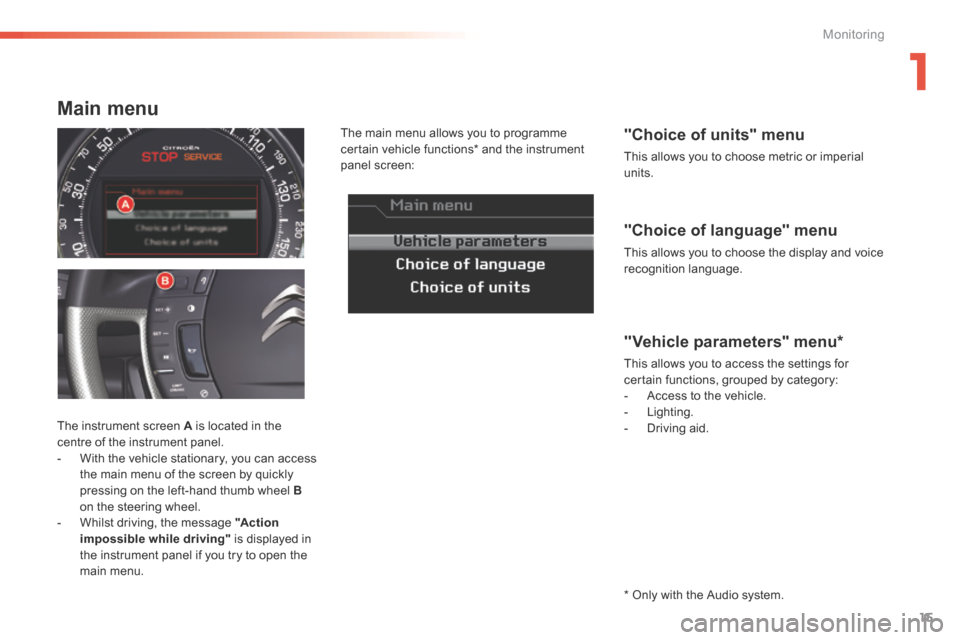
15
"Choice of language" menu
This allows you to choose the display and voice
recognition language.
"Choice of units" menu
This allows you to choose metric or imperial
units.
The main menu allows you to programme
certain vehicle functions* and the instrument
panel screen:
The instrument screen A is located in the
centre of the instrument panel.
- With the vehicle stationary, you can access
the main menu of the screen by quickly
pressing on the left-hand thumb wheel B
on the steering wheel.
- Whilst driving, the message "Action
impossible while driving" is displayed in
the instrument panel if you try to open the
main menu.
"Vehicle parameters" menu*
This allows you to access the settings for
certain functions, grouped by category:
- Access to the vehicle.
- Lighting.
- Driving aid.
Main menu
* Only with the Audio system.
1
Monitoring
Page 18 of 362
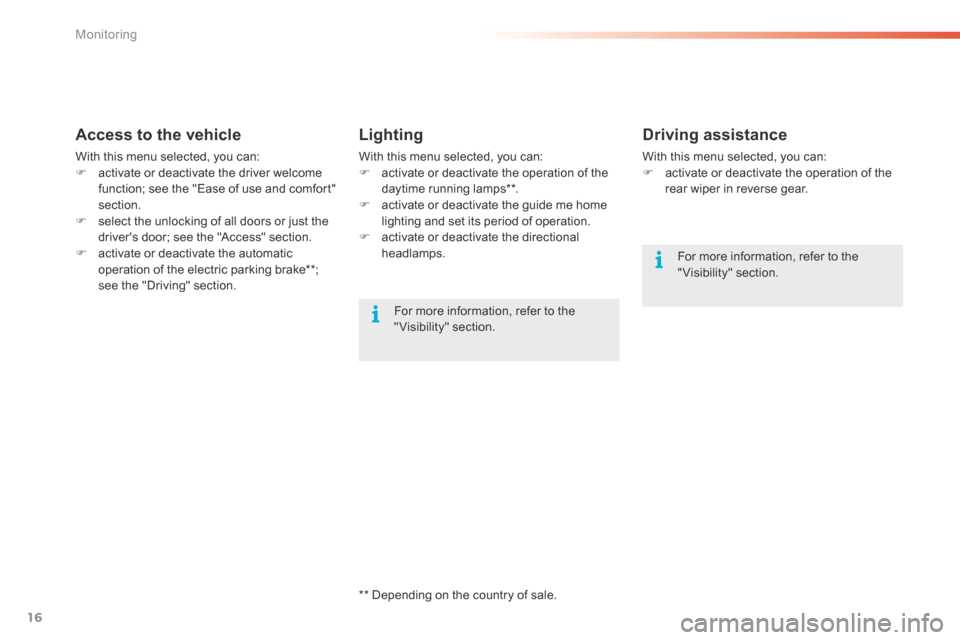
16
Access to the vehicle
With this menu selected, you can:
F activate or deactivate the driver welcome
function; see the "Ease of use and comfort"
section.
F select the unlocking of all doors or just the
driver's door; see the "Access" section.
F activate or deactivate the automatic
operation of the electric parking brake**;
see the "Driving" section.
Lighting
With this menu selected, you can:
F activate or deactivate the operation of the
daytime running lamps**.
F activate or deactivate the guide me home
lighting and set its period of operation.
F activate or deactivate the directional
headlamps.
Driving assistance
With this menu selected, you can:
F activate or deactivate the operation of the
rear wiper in reverse gear.
For more information, refer to the
"Visibility" section. For more information, refer to the
"Visibility" section.
** Depending on the country of sale.
Monitoring
Page 19 of 362
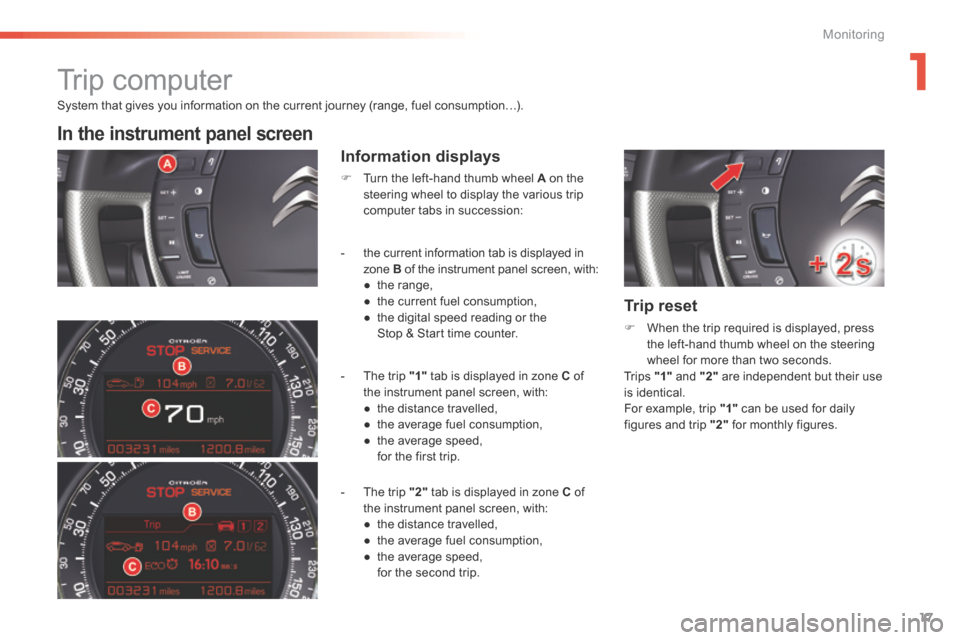
17
System that gives you information on the current journey (range, fuel consumption…).
In the instrument panel screen
Information displays
F Turn the left-hand thumb wheel A on the
steering wheel to display the various trip
computer tabs in succession:
Trip computer
- the current information tab is displayed in
zone B of the instrument panel screen, with:
● the range,
● the current fuel consumption,
● the digital speed reading or the
Stop & Start time counter.
- The trip "1" tab is displayed in zone C of
the instrument panel screen, with:
● the distance travelled,
● the average fuel consumption,
● the average speed,
for the first trip.
- The trip "2" tab is displayed in zone C of
the instrument panel screen, with:
● the distance travelled,
● the average fuel consumption,
● the average speed,
for the second trip.
Trip reset
F When the trip required is displayed, press
the left-hand thumb wheel on the steering
wheel for more than two seconds.
Tr i p s "1" and "2" are independent but their use
is identical.
For example, trip "1" can be used for daily
figures and trip "2" for monthly figures.
1
Monitoring
Page 20 of 362
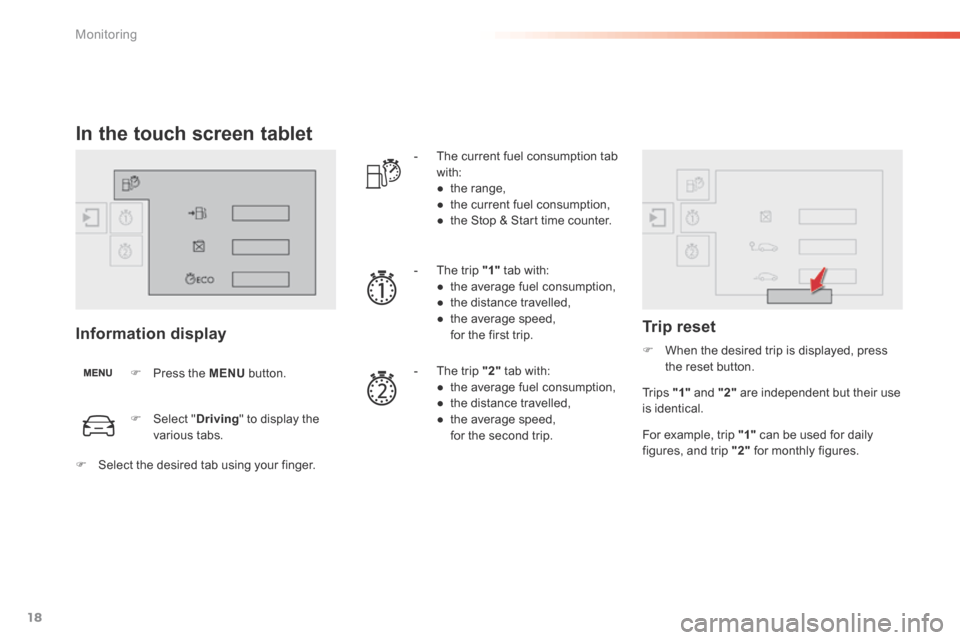
18
In the touch screen tablet
Information display
F Press the MENU button. -
The current fuel consumption tab
with:
● the range,
● the current fuel consumption,
● the Stop & Start time counter.
- The trip "1" tab with:
● the average fuel consumption,
● the distance travelled,
● the average speed,
for the first trip.
- The trip "2" tab with:
● the average fuel consumption,
● the distance travelled,
● the average speed,
for the second trip.
Trip reset
F When the desired trip is displayed, press
the reset button.
For example, trip "1" can be used for daily
figures, and trip "2" for monthly figures.
Tr i p s "1"
and "2" are independent but their use
is identical.
F Select " Driving " to display the
various tabs.
F Select the desired tab using your finger.
Monitoring